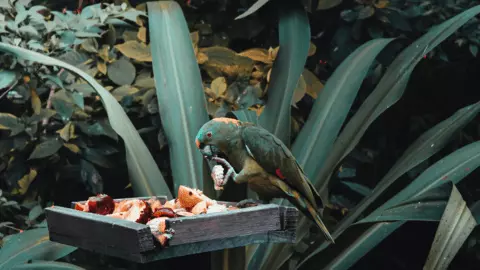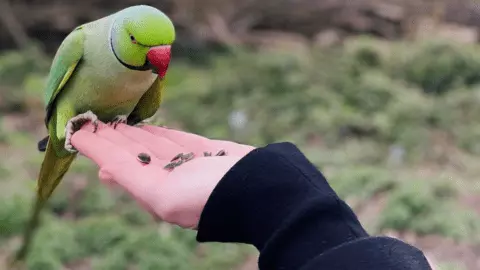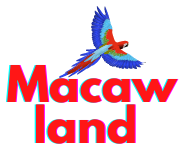Raising a parrot is like carrying a baby in the house. Because similar to human beings, they also require proper nutrition, entertainment, and other necessities to grow up. Almost all professional breeders or bird owners offer a healthy diet based on parrot species like Monk Parakeet, Cockatiel, African Grey, Moluccean Eclectus, Macaw, and more.
But what do you feed parrots? Is your diet routine similar to any professional parrot owner’s? If not, ensure you offer them nutrition-balanced crumbles or pellets, fresh veggies, fruits, plants, seeds, or nuts as a treat since breeders provide these foods.
Remember, malnutrition can be the root of any sickness in parrots! So, today we’ll provide some best healthy food tips for your newcomer parrot buddy to let them grow to be social and friendly, playful birds in the house.
The Importance of a Balanced Diet for Parrots
Parrots, like all living beings, thrive best when their dietary needs are met with precision and care. A balanced diet is not just about filling their feeders but ensuring that what they consume promotes their overall well-being.
Nutrition-Balanced Crumbles or Pellets:
These are specially formulated to provide parrots with essential nutrients. They are often fortified with vitamins and minerals that might be missing from other food sources. Brands have researched and developed these to mimic the diverse nutrients parrots would get in the wild.
Fresh Vegetables:
Vegetables like carrots, broccoli, and leafy greens are packed with vitamins and minerals essential for parrot health. They also provide hydration and can be a source of entertainment as parrots enjoy foraging.
Fruits:
Fruits like apples, bananas, and berries offer essential vitamins and are often favored by parrots for their sweet taste. However, they should be given in moderation due to their sugar content.
Seeds and Nuts:
While seeds and nuts are a natural part of a parrot’s diet, they should be given in moderation. They are energy-dense and can lead to weight gain if overfed. However, they are also a source of essential fatty acids and proteins.
Expert Recommendations on Diet Composition
Board-certified avian veterinarians emphasize that a parrot’s diet should consist of 50-70% high-quality pellets. The remaining 30-50% should be fresh foods, ensuring a mix of vegetables, fruits, and occasional seeds or nuts. Brands like Lafeber, Harrison’s, and Roudybush come highly recommended by experts.
What Do Parrots Usually Eat?

We claim parrot birds as scavengers that will eat anything they find nearby. Typically, parrots’ diet might vary based on the species, but they often prefer to eat fruits, vegetables, leaves, grains, nuts, seeds, or insects. Offering them these foods can be the best source of nutrition, and feeding them twice a day would be enough for their growth.
Fruits are veggies and first-impression food with low fat for the parrot to cover the need for vitamins and minerals. The best idea would be excellent quality pellets with fresh vegetables and fruits in the parrot’s diet.
For example, small birds like monk Parakeet or Budgies can thrive on a blend of premium quality seeds, pellets, and veggies for having high metabolism and calorie intake. Bugdies will adore leafy veggies such as romaine lettuce, bok choy, spinach, broccoli, bell pepper, Swiss chard, and other foods. We also noticed parrots like cockatiels might like popcorn, lobster, eggs, asparagus, and even butter.
What Do Baby Parrots Eat?

Regurgitated foods are given on their diet for the little champ baby parrots. For more tips, we have some ideas below to feed your baby bird.
- Weaning a baby parrot onto soft food should be the priority, then moving on to pellets or other fresh foods.
- Birds like baby Macaw or other parrot species can consume fruits, vegetables, grains, seeds, nuts, or insects.
- Since young birds often stay inside the cage, perches will be great to offer.
- Baby parrots can wean more easily onto the cup of prepared parrot food with hot water moistened than raw veggies or seeds.
- And make sure you feed your baby bird with syringes or a spoon.
What Is A Parrot’s Favorite Food: 15 Foods Parrots Prefer

Most specifically, parrots love fresh foods and vegetables as these foods are easier to consume. But they enjoy foods such as
- Apple
- Mango
- Banana
- Grapes
- Orange
- Papaya
- Pomegranates
- Carrot
- Beetroot
- Peas
- Sweetcorn
- almonds
- walnuts
- sunflower seeds
- Coconut meat.
Toxic Foods: What to Avoid

Ensure your parrot’s safety by avoiding:
- Alcohol
- Avocado
- Chocolate
- Coffee and Caffeine
- Onions and Garlic
- Certain fruit seeds and pits
- Uncooked beans

Transitioning Diets Safely
Switching from seeds to pellets? Introduce the new food gradually. Start by mixing a small amount of pellets with seeds, increasing the pellet proportion over a few weeks. Monitor your parrot’s health and consult a vet if any issues arise.
Essential Nutrition Types For A Parrot’s Diet Chart
You cannot guarantee that your parrot will get the proper nutrition each day since offering all the necessary vitamins or minerals on time is only sometimes possible. But lack of proper diet will cause health issues or suffering throughout the entire life of the parrot. Therefore, you should always ensure the ideal amount of vitamin, protein, or calcium level in your food diet.
| Nutrition Type | Problems Of Not Having | Benefits Of Having |
|---|---|---|
| Protein | It can make it difficult to fly or take part in other activities and ultimately they become tired and depressed. | Proper levels of proteins will ensure strong muscles and tissue. |
| Calcium | Causes health problems such as fractures, seizures, anxiety, soft or weak beaks, and some other problems. | Parrot’s connective tissues, plumage structure, and bone and beak forms will remain good by having calcium in their diet. |
| Vitamin A | A lack of vitamin A can cause faded feathers, breathing issues, scaly feet, or lack of mucus comes near the eyes, nasal passages, or throat. | For the development and repair of tissue, healthy bones, eyes, and hearing, Vitamin A is crucial! |
| Vitamin B | A deficiency of vitamin B such as B6, B9, or B12 makes it a challenge to digest food and take nutrition. | Keep the overall health good and help to deal with stress during periods like mating or moulting. |
| Vitamin D | Several sicknesses such as less egg outcome, brittle shells, oversized or soft beaks, seizures, spayed legs, knee, or fractures. | Hight amount of vitamin D confirms the presence of calcium. It produces whenever the oil reacts with sunlight and meets the need (fulfill the wild bird’s needs, not the pet parrot). |
What Do You Feed Parrots: Safe And Unsafe Food List
So, you’ve learned free-feeding the parrot a good pellet diet. You sometimes give the parrot chopped fresh vegetables, fruits, seeds as carbs or fat, nuts, and some human meals. But what food for parrots at home is good, and what’s toxic for them? Let’s explore the facts in the chart.
| Food Quality | Food Names |
|---|---|
| Safe | Pellets, corn, seeds, melon, banana, apples, kiwi, berries, cherries, Dates, Figs, Pears, Pineapple, Plums, Mango, Papaya, Strawberries, Peaches, Parsnips, asparagus, cucumber, carrots, cabbage, Butternut squash, Kale, Dandelion greens, Pea pods, Cuttlefish and Oyster shells. |
| Moderation | Dandelion, grapes, whole grains, hard-boiled eggs, unsalted nuts, Dandelions, Chickweed, Hawthorn berries, beans (cooked), lean meat (cooked), potatoes (cooked), and fish (cooked). |
| Not Suggested | High-sugar food, high-fat meals, junk food, peanuts, dairy food, human food, and fried food items. |
| Toxic Food | Avocado, alcohol, coffee, tea, chocolates, fruit seeds, Mushrooms, onions, garlic, fruit seeds, and rhubarb. |
Parrot Feeding Daily Chart
You must be thinking about the proper diet plan, right? No worries, since we have regular diet planning for every pet owner in the town.
| Bird Size | Seeds | Pellets | Fruit or Vegetable | Treats |
|---|---|---|---|---|
| Small parrots such as budgies, lovebirds, canaries, or parrotlets | 40-60% of total daily diet or75% commercial pellets | 40-60% of total daily diet or75% commercial pellets | Small pieces similar to 1 to 2 teaspoons | A small amount in a week |
| Medium parrots like cockatiels, conures, caiques | 1-3 tbsp. seeds or1-3 tbsp.pellets | 1-3 tbsp. seeds or1-3 tbsp. pellets | Include 20-25% of a daily diet. (mixed chopped fruits and vegetables) | A small amount in a week |
| Large macaws, Amazon, Eclectus, cockatoo, African grey | 2-6 tbsp. seeds or3-6 tbsp. pellets | 3-6 tbsp. seedsor3-6 tbsp. pellets | Include 20-25% of a daily diet. (mixed chopped fruits, and vegetables) | A small amount in a week |
Also Read>>> What is the difference between a parrot and a macaw
How Many Times Should I Feed My Parrot?
Feeding the parrot twice a day is enough for the health of your bird to remain playful and cheerful. But ensure you clean the remaining food after waiting an hour to avoid spoilage.
1 to 2 teaspoons of seeds daily will be sufficient for your parrot. Offer them pellets after they complete the bird seed or other foods in the morning. Offering freshly sliced foods or veggies can be given each day.
FAQ
In the next section, you’ll find some common questions related to the parrot’s food habits that should come into every reader’s mind. So, make sure you take a look at the Q&A part.
What do parrots eat in the wild?
Parrot birds are known as omnivores, so they usually eat mixed foods and diets based on their environment. The bird enjoys various plant and animal items in the wild such as fruits, vegetables, seeds, nuts, grains, leaves, flowers, and insects.
What human food is safe for parrots?
Bird species commonly eat a lot of human meals if appropriately prepared. We should also regularly feed them human foods like
1. Raw or cooked vegetables such as tomato, cauliflower, spinach, and more.
2. Cooked grains such as quinoa, barley, amaranth, tiff, buckwheat, brown rice, or other types of rice.
3. Fresh fruits like bananas, mangoes, apples, and more.
4. Different types of seeds or nuts.
5. Peanut butter and some other health-beneficial foods that humans love.
Does a parrot eat chilies?
We found some parrots experienced digestion or sensitivity problems when they consumed hot pepper as their primary food source. But red habanero and fresh or dried chili peppers can be suitable for the parrots as a nutrient source. Chilies are safe as parrots have fewer taste buds and don’t understand capsaicin’s effects.
What is a parrot’s Favorite fruit?
Most parrots love to eat vegetables and fruits. Therefore, you may feed the finest fresh fruits to your parrot like
1. Banana
2. Berries
3. Grapes
4. Mangoes
5. Orange
6. Papaya
7. Nectarines
8. Pomegranates
9. Persimmon
10. Pineapple.
What do you feed African grey parrots?
African grey parrots favor pelleted ideas that are enriched with a variety of fruits and vegetables. But ensure that 75 to 80% of your bird’s diet consists of pellets.
Besides that, they love fresh vegetables, fruits, seeds, leaves, nuts, insects, and more. And best would be feeding tomatoes, spinach, celery, cauliflower, Brussels sprouts, pumpkin, and other vegetable items raw or steamed.
Closing Section
We hope this article has taught the daily food routine for your feather friend Mr. Parrot. So, next time you won’t have to ask what do you feed parrots for nutrition. The best advice from this writing you should take is to feed your bird pellets with a mixture of veggies, fruits, seeds, and nuts.
Besides all the food, ensure you have checked all the charts we have included related to the routine diet, proper nutrition level, and the foods you should offer or avoid. And, if you have a parrot, remember to offer them the right food two times a day!

Hi, I’m Regina Rios. Just another bird lover who loves to share knowledge from personal experience. I’ve grown up with pet birds since childhood as my mommy also loves birds. As I can’t pet many birds in open air in my house as my mom does; I created my first bird cage on my rooftop using wood, copper wire, and a metal shed in 2018 and start collecting pet birds. Now, I have so many pet birds such as Macaws, Parrot, Cockatiel, Parakeet, and others. Not only that, if I see natural birds are injured I keep them in my house until they get well. Now, my hobby becomes my income source as my home birds have babies and I sell them to birds lover like mine. I’ve created this blog to inspire others bird owners by sharing my personal knowledge. Good Luck!


